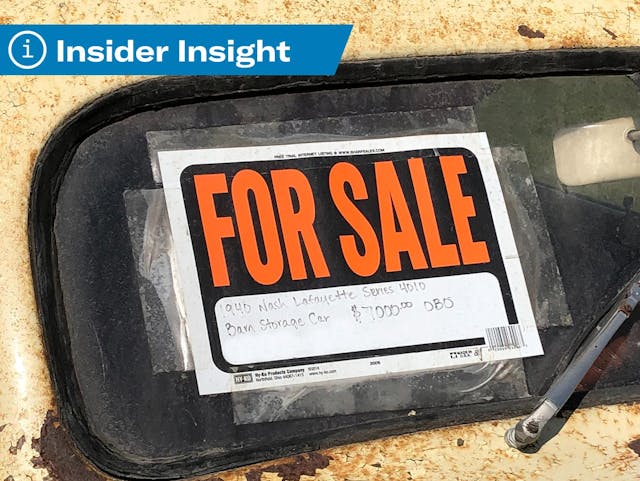The state of 2023’s private collector-car market

Want a better understanding of what’s driving collector car values? Sign up for the Hagerty Insider newsletter.
Scottsdale. Amelia. Monterey. Hagerty Media’s headlines are flush with the names of locales that host some of the biggest collector-car auctions around. Fast-growing auctions like Kissimmee and the seven-day-a-week online world popularized by Bring a Trailer and others ensure that auction transactions stay in the news. All these command attention because they are very public data points and highlight larger market trends.
But what of the private market? While we can’t cover every handshake that takes place on the end of a driveway, we do report periodically on the much larger, if less visible, part of the market. This helps construct a more holistic view of transactions and also reveals some trends not apparent from public sales alone.
Naturally, the private market is, ahem, private, so tracking it is not as straightforward as it is with auctions. But we do have an ace up our sleeves in the form of anonymized data from the insurance side of Hagerty’s business. We see cars added (bought) and removed (sold) from policies.*
It’s important to understand the limitations of this data: For privacy reasons, we can’t drill down into specific sales, and not every enthusiast vehicle is or was on a Hagerty policy, so our view is incomplete. Yet it does provide a significant enough set of data points to build a conservative view of the entire private market.
Big and steady
The first thing you need to remember about the private market is that it’s huge. This past January was the biggest month ever for collector car auctions—nearly 7000 vehicles sold in person and nearly 2000 more online, for total sales of over $600 million. Yet nearly twice as many vehicles changed hands privately during that span, bringing in some $700 million.
The private market is also much more stable than the auctions. It’s grown since 2019, but not at the rate of upstart online auctions, and volume pulled back slightly in 2022, even as the online sales hit their peak.
To some extent, the contraction in the private market represents people choosing to sell their cars via the online auctions. That seems to be particularly the case for vehicles in the $100K–$500K range, where the private market lost share last year. For vehicles below $100K, private transactions continue to rule the day.
That makes sense: Online auctions have enjoyed spectacular, highly publicized success selling expensive vehicles in the past few years, often for higher-than-expected sums. Sellers of six-figure cars, who might have once simply consigned their cars to a dealer, are understandably tempted by the prospect of a “Bring a Trailer premium.” For sellers of lower-priced cars, however, the effort and fees associated with auctions—online or in-person—likely remain a turnoff. (Keep in mind, we don’t consider online classifieds, such as those on Craigslist or Hagerty Marketplace, to be “online auctions.”)
Falling behind inflation
At auctions, we’ve continued on the whole to see cars bring eye-popping sums. That simply hasn’t been the case on the private market, particularly for affordable classics. Blame, perhaps, the fact that privately sold vehicles typically aren’t presented as well as one brought to auction, that buyers and sellers in this world have a “stickier” sense of what things should be worth, or simply that the average person buying an affordable classic these days is on a budget.
Whatever the reason, attainable classics have been trailing inflation. The average value for the 100 most insured vehicles in the Hagerty Price Guide has slipped eight months in a row after adjusting for inflation. This is, in fact, one of the biggest contributing factors to the Hagerty Market Rating’s five-month slide.
Looking good at the top
It might surprise those who think of August’s Monterey Car Week (capped by the Pebble Beach Concours d’Elegance) as million-dollar-car mecca to learn that even at this level, sellers prefer the private market (although here a high-end dealer typically stands in for a for-sale post on Craigslist).
Broadly speaking, though, we saw the momentum at Monterey carry into the private market in late 2022 and early 2023. In fact, the number of vehicles sold privately at $1M+ in the fourth quarter of 2022 exceeded the number sold at auction in the third quarter (which includes Monterey Car Week) by 9 percent.
Much like we’ve seen at the auctions, the biggest winners in this price range are modern exotics. Nearly a third of private transactions were for cars built since 2010. That’s starkly different than the rest of the collector market, where 2010 and newer cars make up less than seven percent of transactions.
While the private market is still where most vehicles are bought and sold, it’s clear that different dynamics are now in play depending on the price point. Auctions are strong in the middle of the market, and we see slower appreciation in the private market for vehicles selling for less than $100K but healthy activity for (often modern) vehicles above $1M. With a possible record year for total sales at auctions held in conjunction with the Amelia concours of early March, it is helpful to remember that not all the action is at the auction.
__
*We remove one side of the transaction if a car moves from one policy to another to avoid double counting. We also remove vehicles that we see sell at auction.
***
Check out the Hagerty Media homepage so you don’t miss a single story, or better yet, bookmark it. To get our best stories delivered right to your inbox, subscribe to our newsletters.
Via Hagerty Insider

